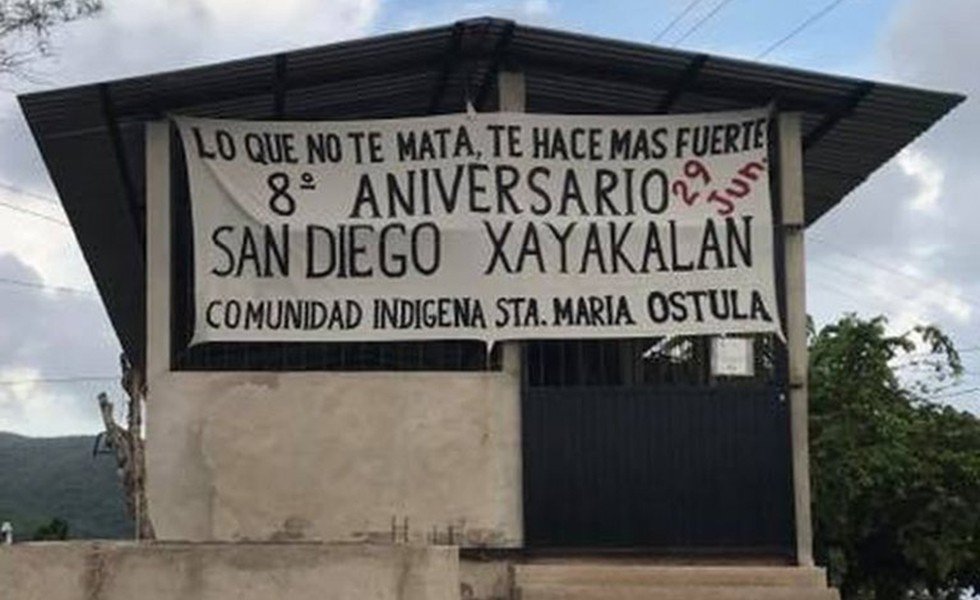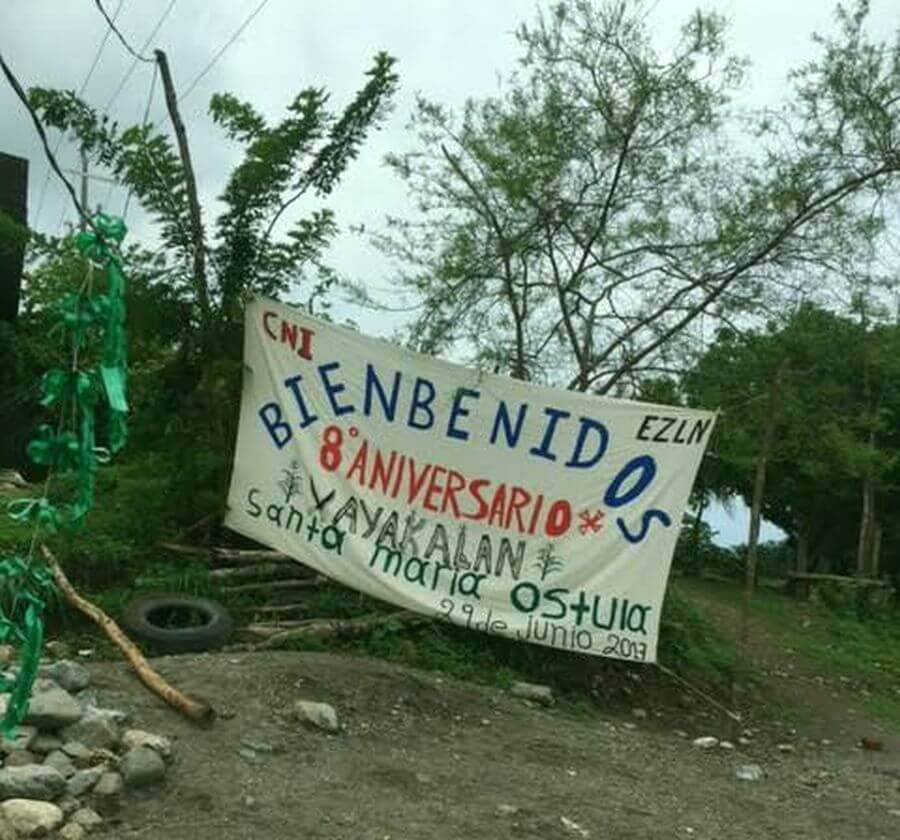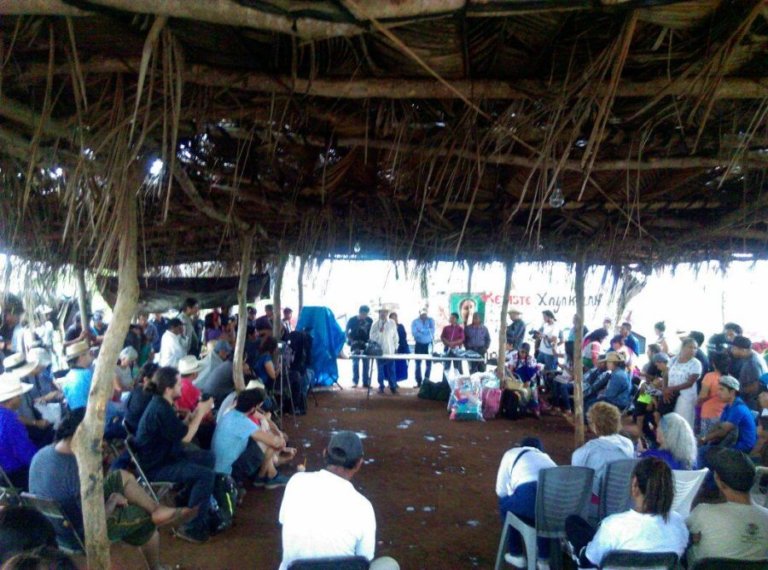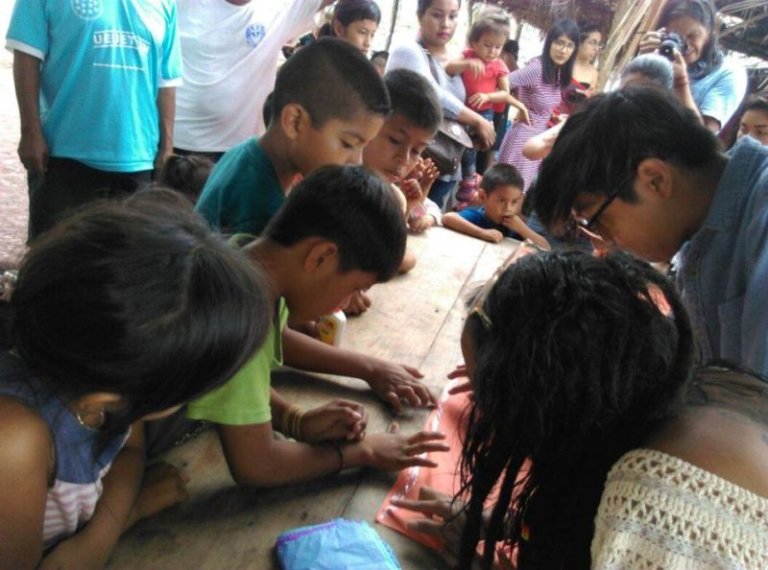Filed under: Indigenous, Land, Mexico, Southern Mexico

Under heavy rains, two busloads of people and dozens of others traveling in cars or public transportation came together in the community of Xayakalan in Ostula, Michoacán, on June 29, 2017. There, the compañeras welcomed us with steaming coffee, tortillas and a delicious stew.
The purpose of the trip? The celebration of the eighth anniversary of one of the most amazing things that’s happened in Mexico in many years ––the recovery of 3000 acres of land stolen from Ostula half a century ago, and the construction of a community where resistance is part of its identity.
A bit of history
In a brief history of the defense of the lands of Santa María Ostula and the founding of Xayakalan, the lawyer Carlos Gonzalez told us that for centuries, including the entire twentieth century, the community had constant border conflicts. When a presidential decree issued in 1963 certified that the communal lands rightfully belonged to Ostula, small landowners in La Placita took advantage of errors in the decree to take over thousands of acres. In 2008, they won a court case that took land away from Ostula precisely in the area where they’d obtained concessions from the transnational mining company Termium.
On April 8, 2008, the General Assembly of Ostula decided to wage a legal, political and organizational struggle of their own in defense of their communal property. A commission was established which would be headed by community landholder and school teacher Diego Ramírez. The Commission decided to reorganize the Community Police, which had been disbanded by the Municipal Presidency in 1989.
On July 26, 2008, Diego Ramírez was killed. His mutilated body was thrown onto the beach as a threat to anyone opposing the robbery of communal property. But Carlos Gonzalez said that “the community kept on with its plans and the Commission continued to work. Finally on July 9th, a Permanent Assembly was declared to take charge of the land recovery.”
“It was precisely on a day like today, June 29, 2009, that the community members began to come together ––males above 18 years of age with communal land rights, fathers and sons, born and raised in the community–– and they met in Duin to come here and take back their lands… At 3 0’clock in the afternoon, we met in the house of the comrade who had done most to foster the struggle, don Trinidad de la Cruz…”
The comrades were meeting to decide on a plan of attack to recover the lands. They decided that four commandos would go straight into the territory and three would pull back to La Peña. Those out in front would open the way for the community to enter and take up positions.
“After quite a while, it must have been around 6:30 pm, I’ll never forget that a young community member, the Second in Command in one of the teams, asked me, “Hey counselor, what else do we need to go on ahead? “I don’t know,” I said. “Maybe we need some balls”. Then the comrade named Cemeí Verdía, who was under the orders of Commander Fredi, said, “Well, I´ve got ‘em. Come on! Let’s go!” He jumped in his truck and headed this way. Then all the other commandos came with him. And that’s how they began to recover the land that rightfully belongs to the community based on ancient land titles”.
When they came into the territory, the comrades were met with a hail of bullets, and one person was wounded. They later found out that the armed attack came from an organized crime group headed by Federico González of the Milenio Cartel, who then joined the ranks of the Familia Michoacana and later, the Templarios. Because of the attack, the comrades were obliged to arrest some of the small landowners and residents of La Placita.
On July 1, the construction of the Xayakalan community began, and 20 days later, it was finished, as previously planned. On July 2, the Mexican Navy stationed itself just outside La Placita, “and that day the war against our community began”.
“We aim to get organized for life”
This eighth anniversary celebration was marked by the presence of the spokeswoman of the National Indigenous Congress (CNI), María de Jesús Patricio Martínez, better known as Marichuy, who was accompanied by several council members and representatives of indigenous communities.
CNI support for the land recovery in Xayakalan has been important from the beginning. At a meeting held on June 13-14, 2009, the Congress adopted the Ostula Manifesto on the right of indigenous peoples to self-defense. And after the lands were taken back, on August 9, the CNI published the Declaration of Xayakalan, which says that defending indigenous territory is defending the people and that self-defense is non-negotiable.
During the program, Marichuy said:
Good afternoon to my brothers and sisters here in Ostula and to those of you from other indigenous communities, also to those from the cities and from independent media who’ve come to help get this information to other places. It’s up to me to explain why we’re going to participate in the 2018 process.
The spokeswoman explained that there has been a lot of uncertainty because it’s to the advantage of powerful interests that indigenous peoples are divided and fighting among themselves. This makes it easier to loot and rob natural resources, water, and land. Projects imposed from above only aim to plunder the natural wealth, provoking division and confrontation. “When people try to get organized, we face repression, forced disappearances, imprisonment, or exile.”
In this situation, said the spokeswoman, the CNI held consultations and decided to take a giant step forward and put their problems on the national agenda. As of now, 71 councilpersons have been selected, and after consultations are held with more communities, there should be around 200.
Our goal is not to rule from above or occupy the presidential mansion (Los Pinos), but instead to figure out how we’re going to get organized all together to bring down this capitalist system that has only brought death and destruction to our communities. How we´re going to stop this war being waged from above against the communities. Our goal is about organization. Organizing ourselves on the ground along with people from the cities. We aim to get organized for life. For everything around us ––trees, hills, water, natural resources, people. We have to help each other out.
Voices from different territories
Most of us found time to swim or wade in the ocean while we were in Xayakalan, and got to know people from different places. During the program on Thursday and Friday, support for the eight years of resistance in the community was expressed in words, music and art. The engravings done by the Brigada Cultural Subversiva attracted a lot of attention, as did the artwork and games of the children who were present.
“If we’re here, it’s because we think different,” said the representative from Comachuen, Michoacán, who went on to speak about the common problem of so many communities under attack by organized crime in collusion with the government and political parties. “We’re not here to celebrate our dead, like Don Trini. We’re here to learn from them because they’re our roots.”
Compañera Dulce María brought a message from Tepoztlán about the ecocide going on there through the clear cutting of trees to widen the highway that runs through the Tepozteco. “For us as peoples, the land that feeds us is primordial,” say the comrades, although voracious capitalism has its ways of buying off people, plundering resources and making attempts on our lives. From their encampment, they express their appreciation for the resistance and organization shown in Xayakalan, which serves as an example of struggle.
Three comrades from Cherán brought greetings from the Purépecha people who confronted with the plunder of their trees and territory in 2010, and put an end to most of it, throwing out the political parties and corrupt authorities and relying on community autonomy and self-determination. “But we’re aware that the government and capitalism live off of what they rob from original peoples. So we’re still in struggle.”
One compañera and four compañeros from Zacualpan, Colima, came to bring greetings to the Xayakalan community and share their experience of successful resistance against a mining project in their territory that would have poisoned a spring and robbed the Nahua community of their resources and territory. “We thank you for your resistance. And we have to keep on resisting because we’re the ones who own our lands, our communities and our territories,” said the compañera.
Compañera Magdalena García Duran stated that the spokeswoman Marichuy, chosen by the other Council members, is the voice of the voiceless. She will speak for the indigenous peoples and communities even when “nobody wants to see us, nobody wants to know anything about us. Such people discriminate against us and despise us. What we want is to organize ourselves to create something that is just, where the people rule and the government obeys.”
The Nahua people of San Pedro Tlanixco, the Movement for the Freedom of the Defenders of Water and Life in Tlanixco, and Radio Tlanixco, all sent combative greetings to the people of Xayakalan along with “recognition and admiration for the righteous struggle, resistance, and rebellion that has been ongoing here every June 29th for eight years. Today we stand with you in the struggle to defend your territory.”
A letter was also read from the Supreme Indigenous Council of the Otomí people of San Francisco Xochicuautla, who are part of the traditional authorities of the people. Although they weren’t able to be present at the event, they said that “we want to keep strengthening our resistance along with you, who are righteous, exemplary, and conscious peoples. We want to tell you that we are with you because your struggle is our struggle.”
The representative of the Wixarika people said: “I think this talk, as they said at the beginning of the program, this conversation, this interchange of words, has been really helpful to us.” Among the common problems mentioned were the invasions, mining, violations of sacred places, and activities of political parties. The comrade added the problem of some religions that have come into their territory with practices alien to their customs. He stated that in order to support our spokeswoman, “it will be necessary to invent another kind of politics, another way of convincing people, another way of teaching ideas.”
Interview with Ostula’s delegate to CNI
In an interview, the delegate to the CNI from Ostula, Geronimo Flores Cárdenas, responded to the question: What would you like for the world to know about Xayakalan?
“That Xayakalan continues to struggle in defense of the land, life, and peace, and also to bring justice and security, but true security, not the security that the bad governments want to give us. We want to tell the world that we’re resisting, come what may.”
For more than a year before taking back the land, says the delegate, assemblies were held in Ostula to discuss it. The organization of the Community Police, now called the Community Guard, was an important step, and the statements of the CNI were important to spread the word “to all peoples, nations and tribes, not only in this country, but in the world, to free barrios, to farmers, to workers, because our struggle is not only limited to this community. There’s been support from people in other communities and other countries, too.”
After the land recovery, there was heavy repression in Ostula, says Gerónimo, including the deaths of 34 people and disappearance of six. One comrade who was killed was Trinidad de la Cruz. “The compañero had a strong character. He always said that we have to move on ahead and not allow people from outside the community to trample on us.” Pedro Leyva was also killed. “Sometimes Pedro was part of commissions that held meetings. If he had to speak to high government officials, he told them the truth. Maybe that’s why they killed him.”
Justice has still not been done for a single one of these crimes. “The security that the government provides is worthless because it doesn’t protect the people. It simply protects the interests of the capitalists,” says the delegate.
Many families who were threatened by organized crime in collusion with the government found it necessary to get out of Xayakalan, but in 2014, they were were ready to come back. “We began to reorganize with the support of the self-defense groups that formed in Tierra Caliente here Michoacán. We kicked organized crime out of our territories.” Gerónimo explained that the self-defense groups are from different indigenous and non-indigenous communities, while the Community Guard provides security within indigenous communities. In Ostula, it operates under the authority of the Assembly.
“This year we’re going to be supporting la compañera María de Jesus, getting organized on the ground to stop all the death and destruction and to struggle for life. And we’re going to keep on resisting here in Xayakalan. Right now everything’s calm. There are no deaths, no disappearances, no extortions. We’ve been building more houses and more schools. We send greetings to all people and groups in struggle, and we want the whole world to know that if we get organized, we can do all kinds of things.”
To read an article about Xayakalan written by carolina in January of 2011, click here.












